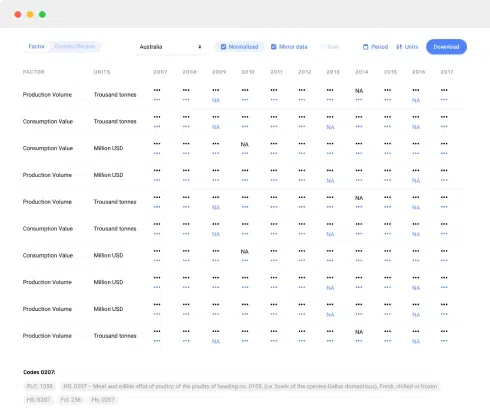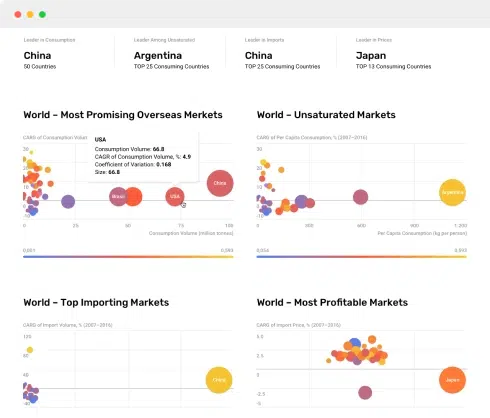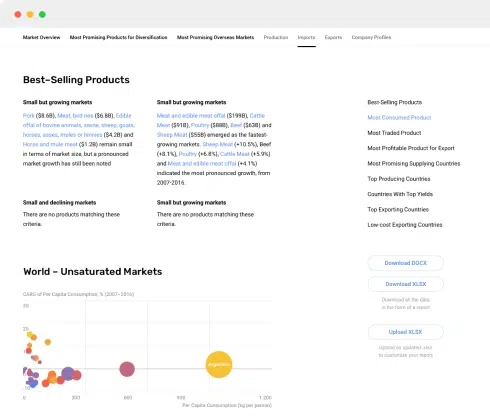
Asia-Pacific - Wheat - Market Analysis, Forecast, Size, Trends and Insights
Get instant access to more than 2 million reports, dashboards, and datasets on the IndexBox Platform.
View PricingAsia-Pacific: Wheat Market 2025
Wheat Market Size in Asia-Pacific
The Asia-Pacific wheat market contracted slightly to $X in 2022, reducing by -2.7% against the previous year. Over the period under review, consumption, however, saw a relatively flat trend pattern. As a result, consumption attained the peak level of $X. From 2018 to 2022, the growth of the market remained at a lower figure.
Wheat Production in Asia-Pacific
In value terms, wheat production fell to $X in 2022 estimated in export price. Overall, production, however, continues to indicate a pronounced contraction. The pace of growth was the most pronounced in 2017 when the production volume increased by 50%. Over the period under review, production attained the peak level at $X in 2019; however, from 2020 to 2022, production stood at a somewhat lower figure.
The countries with the highest volumes of production in 2022 were China (X tons), India (X tons) and Australia (X tons), together accounting for 89% of total production.
From 2012 to 2022, the most notable rate of growth in terms of production, amongst the key producing countries, was attained by Australia (with a CAGR of +1.6%), while production for the other leaders experienced more modest paces of growth.
In 2022, the average wheat yield in Asia-Pacific rose to X tons per ha, surging by 1.9% against the year before. The yield figure increased at an average annual rate of +1.5% from 2012 to 2022; the trend pattern remained consistent, with only minor fluctuations in certain years. The pace of growth appeared the most rapid in 2017 when the yield increased by 5.5%. Over the period under review, the wheat yield hit record highs in 2022 and is expected to retain growth in years to come. Despite the increased use of modern agricultural techniques and methods, future yield figures may still be impacted by adverse weather conditions.
In 2022, approx. X ha of wheat were harvested in Asia-Pacific; shrinking by -1.7% on 2021 figures. In general, the harvested area recorded a relatively flat trend pattern. The pace of growth appeared the most rapid in 2021 when the harvested area increased by 3.6% against the previous year. Over the period under review, the harvested area dedicated to wheat production reached the maximum at X ha in 2015; however, from 2016 to 2022, the harvested area remained at a lower figure.
Wheat Exports
Exports in Asia-Pacific
In 2022, shipments abroad of wheat increased by 12% to X tons, rising for the third consecutive year after two years of decline. Overall, exports showed a notable expansion. The growth pace was the most rapid in 2021 when exports increased by 179%. The volume of export peaked in 2022 and is expected to retain growth in the immediate term.
In value terms, wheat exports skyrocketed to $X in 2022. Over the period under review, exports saw a moderate increase. The most prominent rate of growth was recorded in 2021 with an increase of 200%. The level of export peaked in 2022 and is expected to retain growth in the immediate term.
Exports by Country
Australia was the main exporting country with an export of about X tons, which reached 81% of total exports. It was distantly followed by India (X tons), committing a 19% share of total exports.
Exports from Australia increased at an average annual rate of +2.0% from 2012 to 2022. At the same time, India (+4.0%) displayed positive paces of growth. Moreover, India emerged as the fastest-growing exporter exported in Asia-Pacific, with a CAGR of +4.0% from 2012-2022. India (+2.9 p.p.) significantly strengthened its position in terms of the total exports, while Australia saw its share reduced by -2.5% from 2012 to 2022, respectively.
In value terms, Australia ($X) remains the largest wheat supplier in Asia-Pacific, comprising 82% of total exports. The second position in the ranking was held by India ($X), with an 18% share of total exports.
In Australia, wheat exports increased at an average annual rate of +4.0% over the period from 2012-2022.
Export Prices by Country
In 2022, the export price in Asia-Pacific amounted to $X per ton, increasing by 23% against the previous year. Over the period from 2012 to 2022, it increased at an average annual rate of +1.7%. As a result, the export price attained the peak level and is likely to continue growth in the immediate term.
Average prices varied noticeably amongst the major exporting countries. In 2022, amid the top suppliers, the country with the highest price was Australia ($X per ton), while India stood at $X per ton.
From 2012 to 2022, the most notable rate of growth in terms of prices was attained by Australia (+1.9%).
Wheat Imports
Imports in Asia-Pacific
In 2022, purchases abroad of wheat decreased by -4.2% to X tons for the first time since 2018, thus ending a three-year rising trend. Total imports indicated a remarkable increase from 2012 to 2022: its volume increased at an average annual rate of +5.4% over the last decade. The trend pattern, however, indicated some noticeable fluctuations being recorded throughout the analyzed period. Based on 2022 figures, imports increased by +23.2% against 2018 indices. The most prominent rate of growth was recorded in 2016 when imports increased by 27% against the previous year. Over the period under review, imports reached the peak figure at X tons in 2021, and then fell in the following year.
In value terms, wheat imports surged to $X in 2022. Total imports indicated a strong expansion from 2012 to 2022: its value increased at an average annual rate of +6.4% over the last decade. The trend pattern, however, indicated some noticeable fluctuations being recorded throughout the analyzed period. Based on 2022 figures, imports increased by +67.4% against 2017 indices. The pace of growth appeared the most rapid in 2021 with an increase of 29% against the previous year. Over the period under review, imports reached the peak figure in 2022 and are expected to retain growth in the near future.
Imports by Country
Indonesia (X tons), China (X tons), the Philippines (X tons), Bangladesh (X tons), Japan (X tons), South Korea (X tons) and Vietnam (X tons) represented roughly 83% of total imports in 2022.
From 2012 to 2022, the most notable rate of growth in terms of purchases, amongst the leading importing countries, was attained by Bangladesh (with a CAGR of +25.4%), while imports for the other leaders experienced more modest paces of growth.
In value terms, Indonesia ($X), China ($X) and the Philippines ($X) constituted the countries with the highest levels of imports in 2022, together comprising 52% of total imports. Japan, South Korea, Bangladesh and Vietnam lagged somewhat behind, together accounting for a further 32%.
Bangladesh, with a CAGR of +21.4%, recorded the highest rates of growth with regard to the value of imports, among the main importing countries over the period under review, while purchases for the other leaders experienced more modest paces of growth.
Import Prices by Country
The import price in Asia-Pacific stood at $X per ton in 2022, surging by 22% against the previous year. In general, the import price recorded a slight increase. As a result, import price attained the peak level and is likely to continue growth in the immediate term.
There were significant differences in the average prices amongst the major importing countries. In 2022, amid the top importers, the country with the highest price was Japan ($X per ton), while Bangladesh ($X per ton) was amongst the lowest.
From 2012 to 2022, the most notable rate of growth in terms of prices was attained by Japan (+2.7%), while the other leaders experienced more modest paces of growth.
Source: IndexBox Platform
Frequently Asked Questions (FAQ) :
This report provides an in-depth analysis of the wheat market in Asia-Pacific. Within it, you will discover the latest data on market trends and opportunities by country, consumption, production and price developments, as well as the global trade (imports and exports). The forecast exhibits the market prospects through 2030.
Product coverage:
- FCL 15 - Wheat
Country coverage:
- Afghanistan
- Australia
- Bangladesh
- Bhutan
- Brunei Darussalam
- Cambodia
- China
- Hong Kong SAR
- Macao SAR
- Cook Islands
- Fiji
- French Polynesia
- India
- Indonesia
- Japan
- Kiribati
- Malaysia
- Maldives
- Marshall Islands
- Micronesia
- Myanmar
- Nepal
- New Caledonia
- New Zealand
- Northern Mariana Islands
- Pakistan
- Palau
- Papua New Guinea
- Philippines
- Samoa
- Singapore
- Solomon Islands
- South Korea
- Sri Lanka
- Taiwan (Chinese)
- Thailand
- Timor-Leste
- Tokelau
- Tonga
- Tuvalu
- Vanuatu
- Vietnam
- Wallis and Futuna Islands
- Lao People's Democratic Republic
- American Samoa
- Democratic People's Republic of Korea
- Nauru
- Niue
- Guam
Data coverage:
- Market volume and value
- Per Capita consumption
- Forecast of the market dynamics in the medium term
- Production in Asia-Pacific, split by region and country
- Trade (exports and imports) in Asia-Pacific
- Export and import prices
- Market trends, drivers and restraints
- Key market players and their profiles
Reasons to buy this report:
- Take advantage of the latest data
- Find deeper insights into current market developments
- Discover vital success factors affecting the market
This report is designed for manufacturers, distributors, importers, and wholesalers, as well as for investors, consultants and advisors.
In this report, you can find information that helps you to make informed decisions on the following issues:
- How to diversify your business and benefit from new market opportunities
- How to load your idle production capacity
- How to boost your sales on overseas markets
- How to increase your profit margins
- How to make your supply chain more sustainable
- How to reduce your production and supply chain costs
- How to outsource production to other countries
- How to prepare your business for global expansion
While doing this research, we combine the accumulated expertise of our analysts and the capabilities of artificial intelligence. The AI-based platform, developed by our data scientists, constitutes the key working tool for business analysts, empowering them to discover deep insights and ideas from the marketing data.
-
1. INTRODUCTION
Making Data-Driven Decisions to Grow Your Business
- REPORT DESCRIPTION
- RESEARCH METHODOLOGY AND THE AI PLATFORM
- DATA-DRIVEN DECISIONS FOR YOUR BUSINESS
- GLOSSARY AND SPECIFIC TERMS
-
2. EXECUTIVE SUMMARY
A Quick Overview of Market Performance
- KEY FINDINGS
- MARKET TRENDS This Chapter is Available Only for the Professional Edition PRO
-
3. MARKET OVERVIEW
Understanding the Current State of The Market and its Prospects
- MARKET SIZE: HISTORICAL DATA (2012–2024) AND FORECAST (2025–2035)
- CONSUMPTION BY COUNTRY: HISTORICAL DATA (2012–2024) AND FORECAST (2025–2035)
- MARKET FORECAST TO 2035
-
4. MOST PROMISING PRODUCTS FOR DIVERSIFICATION
Finding New Products to Diversify Your Business
- TOP PRODUCTS TO DIVERSIFY YOUR BUSINESS
- BEST-SELLING PRODUCTS
- MOST CONSUMED PRODUCTS
- MOST TRADED PRODUCTS
- MOST PROFITABLE PRODUCTS FOR EXPORT
-
5. MOST PROMISING SUPPLYING COUNTRIES
Choosing the Best Countries to Establish Your Sustainable Supply Chain
- TOP COUNTRIES TO SOURCE YOUR PRODUCT
- TOP PRODUCING COUNTRIES
- COUNTRIES WITH TOP YIELDS
- TOP EXPORTING COUNTRIES
- LOW-COST EXPORTING COUNTRIES
-
6. MOST PROMISING OVERSEAS MARKETS
Choosing the Best Countries to Boost Your Export
- TOP OVERSEAS MARKETS FOR EXPORTING YOUR PRODUCT
- TOP CONSUMING MARKETS
- UNSATURATED MARKETS
- TOP IMPORTING MARKETS
- MOST PROFITABLE MARKETS
-
7. PRODUCTION
The Latest Trends and Insights into The Industry
- PRODUCTION VOLUME AND VALUE: HISTORICAL DATA (2012–2024) AND FORECAST (2025–2035)
- PRODUCTION BY COUNTRY: HISTORICAL DATA (2012–2024) AND FORECAST (2025–2035)
- HARVESTED AREA AND YIELD BY COUNTRY: HISTORICAL DATA (2012–2024) AND FORECAST (2025–2035)
-
8. IMPORTS
The Largest Import Supplying Countries
- IMPORTS: HISTORICAL DATA (2012–2024) AND FORECAST (2025–2035)
- IMPORTS BY COUNTRY: HISTORICAL DATA (2012–2024) AND FORECAST (2025–2035)
- IMPORT PRICES BY COUNTRY: HISTORICAL DATA (2012–2024) AND FORECAST (2025–2035)
-
9. EXPORTS
The Largest Destinations for Exports
- EXPORTS: HISTORICAL DATA (2012–2024) AND FORECAST (2025–2035)
- EXPORTS BY COUNTRY: HISTORICAL DATA (2012–2024) AND FORECAST (2025–2035)
- EXPORT PRICES BY COUNTRY: HISTORICAL DATA (2012–2024) AND FORECAST (2025–2035)
-
10. PROFILES OF MAJOR PRODUCERS
The Largest Producers on The Market and Their Profiles
-
11. COUNTRY PROFILES
The Largest Markets And Their Profiles
This Chapter is Available Only for the Professional Edition PRO- Afghanistan
- Australia
- Bangladesh
- Bhutan
- Brunei Darussalam
- Cambodia
- China
- Hong Kong SAR
- Macao SAR
- Cook Islands
- Fiji
- French Polynesia
- India
- Indonesia
- Japan
- Kiribati
- Malaysia
- Maldives
- Marshall Islands
- Micronesia
- Myanmar
- Nepal
- New Caledonia
- New Zealand
- Northern Mariana Islands
- Pakistan
- Palau
- Papua New Guinea
- Philippines
- Samoa
- Singapore
- Solomon Islands
- South Korea
- Sri Lanka
- Taiwan (Chinese)
- Thailand
- Timor-Leste
- Tokelau
- Tonga
- Tuvalu
- Vanuatu
- Vietnam
- Wallis and Futuna Islands
- Lao People's Democratic Republic
- American Samoa
- Democratic People's Republic of Korea
- Nauru
- Niue
- Guam
-
LIST OF TABLES
- Key Findings In 2024
- Market Volume, In Physical Terms: Historical Data (2012–2024) and Forecast (2025–2035)
- Market Value: Historical Data (2012–2024) and Forecast (2025–2035)
- Per Capita Consumption, by Country, 2022–2024
- Production, In Physical Terms, By Country: Historical Data (2012–2024) and Forecast (2025–2035)
- Harvested Area, by Country: Historical Data (2012–2024) and Forecast (2025–2035)
- Yield, by Country: Historical Data (2012–2024) and Forecast (2025–2035)
- Imports, in Physical Terms, by Country: Historical Data (2012–2024) and Forecast (2025–2035)
- Imports, in Value Terms, by Country: Historical Data (2012–2024) and Forecast (2025–2035)
- Import Prices, by Country: Historical Data (2012–2024) and Forecast (2025–2035)
- Exports, in Physical Terms, by Country: Historical Data (2012–2024) and Forecast (2025–2035)
- Exports, in Value Terms, by Country: Historical Data (2012–2024) and Forecast (2025–2035)
- Export Prices, by Country: Historical Data (2012–2024) and Forecast (2025–2035)
-
LIST OF FIGURES
- Market Volume, in Physical Terms: Historical Data (2012–2024) and Forecast (2025–2035)
- Market Value: Historical Data (2012–2024) and Forecast (2025–2035)
- Consumption, by Country, 2024
- Market Volume Forecast to 2035
- Market Value Forecast to 2035
- Market Size and Growth, by Product
- Average Per Capita Consumption, by Product
- Exports and Growth, by Product
- Export Prices and Growth, by Product
- Production Volume and Growth
- Yield and Growth
- Exports and Growth
- Export Prices and Growth
- Market Size and Growth
- Per Capita Consumption
- Imports and Growth
- Import Prices
- Production, in Physical Terms: Historical Data (2012–2024) and Forecast (2025–2035)
- Production, in Value Terms: Historical Data (2012–2024) and Forecast (2025–2035)
- Harvested Area: Historical Data (2012–2024) and Forecast (2025–2035)
- Yield: Historical Data (2012–2024) and Forecast (2025–2035)
- Production, in Physical Terms, by Country: Historical Data (2012–2024) and Forecast (2025–2035)
- Harvested Area, by Country, 2024
- Harvested Area, by Country: Historical Data (2012–2024) and Forecast (2025–2035)
- Yield, by Country: Historical Data (2012–2024) and Forecast (2025–2035)
- Imports, in Physical Terms: Historical Data (2012–2024) and Forecast (2025–2035)
- Imports, in Value Terms: Historical Data (2012–2024) and Forecast (2025–2035)
- Imports, in Physical Terms, by Country, 2024
- Imports, in Physical Terms, by Country: Historical Data (2012–2024) and Forecast (2025–2035)
- Imports, in Value Terms, by Country: Historical Data (2012–2024) and Forecast (2025–2035)
- Import Prices, by Country: Historical Data (2012–2024) and Forecast (2025–2035)
- Exports, in Physical Terms: Historical Data (2012–2024) and Forecast (2025–2035)
- Exports, in Value Terms: Historical Data (2012–2024) and Forecast (2025–2035)
- Exports, in Physical Terms, by Country, 2024
- Exports, in Physical Terms, by Country: Historical Data (2012–2024) and Forecast (2025–2035)
- Exports, in Value Terms, by Country: Historical Data (2012–2024) and Forecast (2025–2035)
- Export Prices, by Country: Historical Data (2012–2024) and Forecast (2025–2035)
Recommended reports
This report provides an in-depth analysis of the wheat market in Asia.
This report provides an in-depth analysis of the wheat market in the U.S..
This report provides an in-depth analysis of the wheat market in China.
This report provides an in-depth analysis of the wheat market in the EU.
This report provides an in-depth analysis of the global wheat market.


